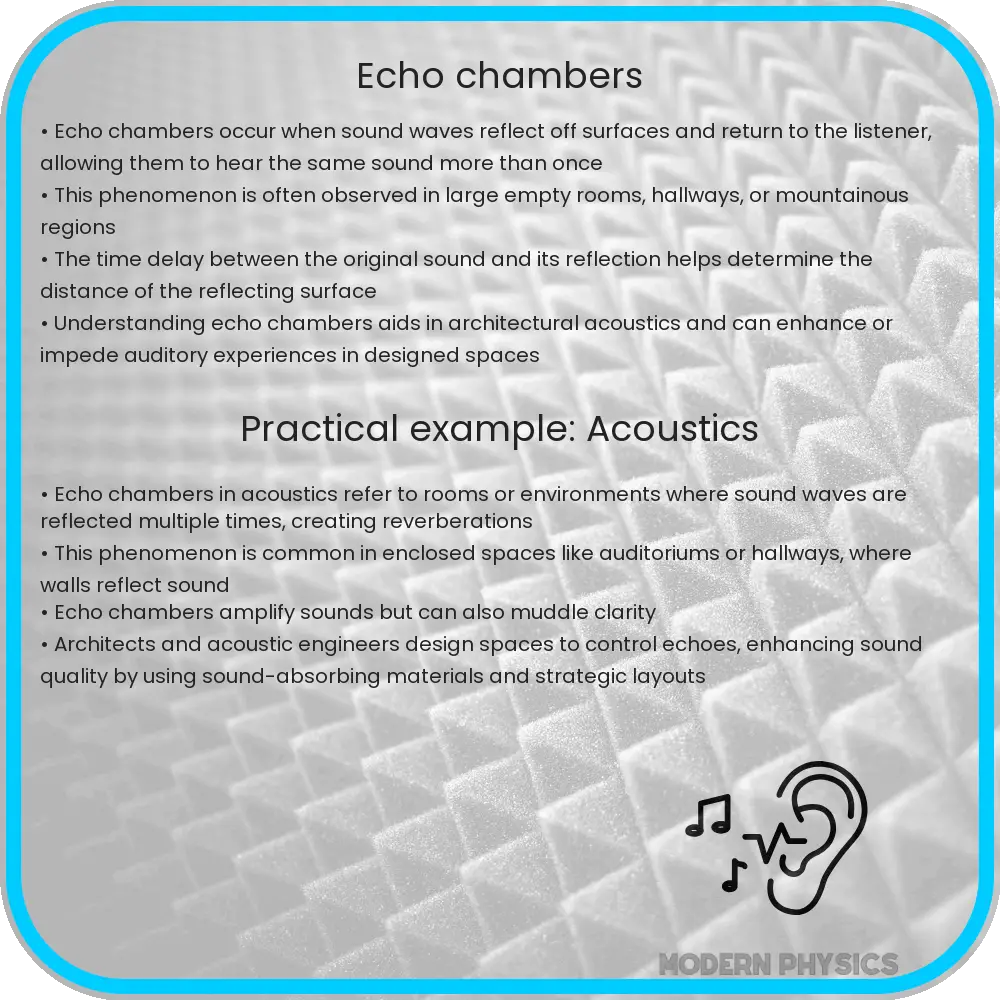An echo chamber is a room designed to reflect sound waves back towards their source, enhancing acoustics for controlled sound effects.

Understanding Echo Chambers: Acoustic Isolation, Sound Reflection & Design
Echo chambers play a crucial role in various applications ranging from sound studios to public buildings. Their design significantly impacts acoustics by manipulating how sound waves travel and interact within a room. In this article, we’ll explore the science behind echo chambers, focusing on acoustic isolation, sound reflection, and how these principles guide effective design.
What is an Echo Chamber?
An echo chamber refers to a room or space designed to reflect sound waves back towards the source. These reflections can enhance sounds or create specific acoustic effects, making echo chambers essential in settings where control over sound is necessary, such as recording studios and concert halls.
Exploring Acoustic Isolation
Acoustic isolation involves preventing sound from entering or leaving a given space. This is critical in echo chambers, where external noise can disrupt the internal acoustics. Acoustic isolation is achieved through various materials and construction techniques that absorb or block sound waves.
- Soundproofing Materials: Dense materials like mass-loaded vinyl, acoustic panels, and specially designed foam are used to absorb or dampen sound.
- Construction Techniques: Decoupling structures to prevent sound transmission through solid materials, using double walls, and floating floors are effective ways to enhance sound isolation.
The Role of Sound Reflection
Sound reflection is a key element in shaping the acoustic environment of an echo chamber. Reflective surfaces can be strategically placed to control how sound waves bounce around the room, affecting clarity, loudness, and the overall sound quality.
- Direct Reflection: Sounds that bounce directly off a surface without any obstruction can create echoes or reverberations. The angle and texture of reflective surfaces greatly influence these effects.
- Diffuse Reflection: To avoid harsh echoes and create a more uniform sound field, surfaces may be designed to scatter sound in various directions, known as diffuse reflection.
Maintaining a balance between absorptive and reflective materials within an echo chamber is critical for optimal acoustics. Surfaces that are too reflective can lead to excessive reverberation, while too many absorbent surfaces might deaden the sound too much.
Design Principles of Echo Chambers
Designing an effective echo chamber requires a deep understanding of the way sound interacts with the environment. Key considerations include:
- Room Geometry: The shape of the room affects sound behavior. Non-parallel walls, for instance, can help in reducing standing waves and flutter echoes.
- Material Selection: Choosing the right materials for floors, walls, and ceilings is crucial to achieve the desired balance of absorption and reflection.
- Speaker and Microphone Placement: Strategic placement of these elements can enhance sound quality by taking advantage of the room’s acoustics.
While designing an echo chamber, it’s essential to tailor each aspect to the specific needs of its intended use—be it recording, performance, or testing. Advanced computer models and acoustic simulation software are often used by engineers and designers to predict how sound will behave in a proposed space, allowing for adjustments before physical construction begins.
As we delve deeper into specifics in the next section, we will explore real-world applications and case studies demonstrating the application of these acoustic principles in echo chamber design.
Real-World Applications of Echo Chambers
Echo chambers are not just theoretical constructs but have practical applications in various fields. From enhancing the acoustical quality of music in performance venues to testing the sound quality of gadgets in controlled environments, their role is pivotal.
- Recording Studios: In recording studios, echo chambers are employed to achieve rich vocal and instrumental sounds. The controlled reflection and absorption make it easier to manipulate sound for desired effects.
- Concert Halls: The design of concert halls heavily relies on the principles of echo chambers to optimize sound distribution and clarity, ensuring that every attendee experiences high-quality acoustics, regardless of their seating position.
- Automotive Testing: Echo chambers are used in the automotive industry to test and refine the acoustics of vehicle cabins, from engine noises to the sound system output, in order to enhance the auditory experience of passengers.
These examples demonstrate the versatility and importance of echo chambers in engineering acoustically pleasing environments.
Case Study: The Sydney Opera House
One of the most illustrious examples of echo chamber application is the Sydney Opera House. Its unique architecture was not only meant to be visually striking but also acoustically superior. The concert hall’s intricate use of reflective and absorbent materials, along with the sophisticated room geometry, creates immaculate sound characteristics that are celebrated worldwide.
Challenges in Echo Chamber Design
While the design and implementation of echo chambers can provide superior acoustic results, they also present unique challenges:
- Material Durability: Choosing materials that maintain their acoustic properties over time while withstanding environmental wear and tear is crucial.
- Technological Integration: Incorporating modern technology, such as digital sound processors and variable acoustics, requires innovative design approaches to preserve sound quality.
- Environmental Considerations: Creating designs that not only meet acoustic demands but also consider environmental impact is becoming increasingly important.
Addressing these challenges requires a blend of traditional acoustics knowledge and modern engineering innovation.
Conclusion
Echo chambers represent a fascinating intersection of physics and engineering, showcasing how sound can be sculpted and controlled through thoughtful design. From constructing venues that deliver crystal-clear acoustics to developing private spaces where artists can perfect their craft, the principles of acoustic isolation and sound reflection play pivotal roles. The design of echo chambers, therefore, does not only concern itself with practical engineering challenges but also with enhancing human experiences in spaces designed for sound. As we continue to push the boundaries of what is possible in acoustic engineering, echo chambers will undoubtedly play a crucial role in shaping the future of auditory environments.
